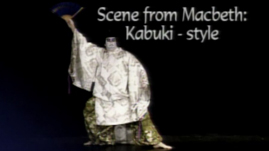Teachers' Domain - Digital Media for the Classroom and Professional Development
User: Preview



In the segment Macbeth: Kabuki Style, Chicago actors Michael Goldberg and Barbara Robertson perform the scene from Macbeth in which Macbeth and Lady Macbeth plot the murder of Duncan. The text used by the actors in this video was adapted to better suit Kabuki-style performance and only resembles the standard text of Macbeth. However, the basic plot elements are intact.
Kabuki literally means “sing, dance, skill.” A shrine dancer named Okuni is credited with giving birth to Kabuki by performing a series of dances in a dry riverbed in Kyoto. Early Kabuki (Onna Kabuki) consisted mainly of dance performances done by women. In 1629, the governing officials deemed these dances a threat to public morals and prohibited women from performing in Kabuki. Following the edict, young men’s Kabuki (Wakushu Kabuki) became popular, but it too was outlawed. Kabuki became the province of adult males, who played all the roles (Yaro Kabuki). In this American Kabuki segment, however, one of the actors is a woman, although in traditional Japanese Kabuki, only men act.
Acting in Kabuki theater is considered a family profession, with sons playing the very same roles as their fathers did, many years later. The most famous family name in Kabuki is Ichikawa. Ichikawa Danjuro I was a pioneering Kabuki actor in the late 17th century, and today Ichiakawa Danjuro XII carries on the family legacy.
Kabuki theater developed alongside Bunraku or “Puppet Theater.” For a brief period in the early 1700s, Bunraku eclipsed Kabuki in popularity, but Kabuki writers borrowed plot lines and effects from Bunraku and won back their audiences. Kabuki theater survives to this day, in part, because of its ability to adjust to changing times, audience expectations, and, particularly, government regulations. For instance, when the government attempted to limit the number of seating tiers in the theater from three to two, resourceful theater managers simply renamed the three tiers: first, mezzanine, and second.
Traditional Kabuki dramas sometimes lasted 11 hours. Because of the show’s length, audience members regularly came and went from the theater, and vendors moved up and down the aisles selling snacks and tea to the boisterous crowd. In 1868, the maximum length was set at eight hours. Today’s Kabuki performances run five hours, and most theaters have two performances a day.
Shozo Sato is a theater director and master of Zen arts. He was officially adopted into the Kabuki family of Nakamura. He is known internationally for producing Kabuki versions of classic Western dramas.
 Loading Standards
Loading Standards